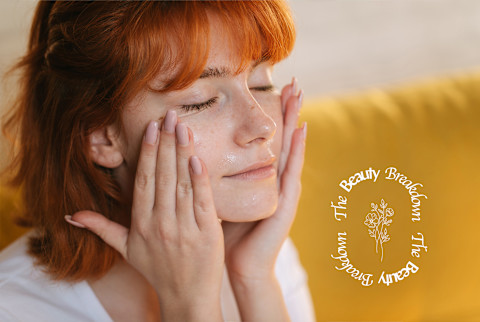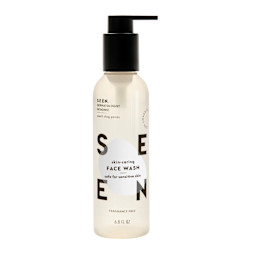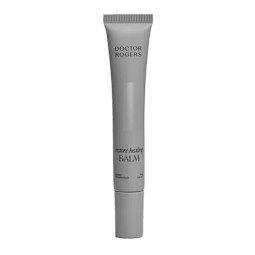Beauty Breakdown: Everything You Need To Know About Eczema Care

While flaky skin and a pesky itch are the hallmark eczema symptoms, this skin disease is highly complex. Eczema is influenced by genetics, environment, and in some cases, even food allergies. There's also a long list of types of eczema that don't get nearly enough time in the limelight.
We know that, as of now, there's no cure—adding to the nuance of this condition. But still, it doesn't make tiptoeing around irritants and triggers any easier.
It's safe to say that eczema deserves some attention, education, and plenty of expert recommendations for proper care, so those struggling can spend more time doing what they love and less time sorting through mixed messaging. Below, you'll find all of that and more from a collective of dermatologists and cosmetic formulation experts.

The 101 on eczema
On a basic level, "Eczema is the most common chronic inflammatory skin disease characterized by skin barrier dysfunction and increased water loss from the skin, leading to inflammation and itching," explains board-certified dermatologist at Hudson Dermatology and Laser Center Aya Ahram, M.D.
You may also notice skin flaking, redness, irritation, and raised bumps. You can experience eczema anywhere on the body, but it's especially common in naturally dry areas like the cheeks, back of the knees, elbows, and hands—as these spots don't have as many active oil glands.
Due to the severe dryness and irritation, these eczema patches can be difficult to treat. Not to mention, a compromised skin barrier is more susceptible to infection, which means keeping the area clean is just as essential.
But as mentioned above, there's more than one kind of eczema. These different forms have unique causes, and some unique care instructions, but are also incredibly similar to one another, which is why so many people often use "eczema" as an umbrella term.
Below, a quick breakdown of the different types from board-certified dermatologist Elise Love, M.D., FAAD:
- Atopic dermatitis: This form is the one most people think of when they hear the term "eczema," Love says. She adds, "In atopic dermatitis, there is a genetic defect in the skin barrier that makes the skin prone to transepidermal water loss [TEWL]1. The dryness eventually leads to itching, redness, and skin irritation."
- Allergic contact dermatitis: This form is caused by an allergic reaction to an ingredient in one or more skin care products. "Unlike hives, this type of allergic reaction typically presents slowly over time and only occurs to products that a person has used multiple times," Love says.
- Irritant contact dermatitis: This form occurs when a product (or a combination of products) causes irritation that disrupts the skin barrier, and similarly to atopic dermatitis, leads to TEWL. So it's not that you're allergic to the product itself but rather using the product too often caused your skin barrier to be compromised. "However, once treated, the person is not prone to repeat episodes unless re-exposed to the irritating triggers," Love adds. Everyone is susceptible to this and a few common causes include frequent hand washing and overuse of retinol or exfoliating acids in your skin care routine.
- Nummular dermatitis: "This is a type of eczema that tends to present in early adulthood with round, dry patches—typically on the arms or legs," Love explains. Researchers don't know the cause yet but have seen a trigger-and-reaction relationship with common eczema triggers like heat, stress, dry air, etc.—more on eczema triggers in a bit.
- Asteatotic eczema: This type of eczema is most common in older adults. "As we get older, the skin naturally has a harder time holding on to moisture, especially the legs. If the skin is dry enough, it will form an eczema rash," Love explains. Still, the general care instructions are the same as for other forms.
If you're unsure which form of eczema you have, you're not alone—it's not an easy mystery to solve. Oftentimes, following a basic protocol will help you figure out which form it may be and your next steps for treatment. So, consider the following protocol universal tips for these pesky dry skin patches.

5 things we're getting wrong right now
Ignoring other forms of eczema besides atopic dermatitis is one thing we often overlook when tending to this skin concern, but it's not the only one. Here are more common mistakes and myths dermatologists see day in and day out:
- Using irritating or fragranced products: Any type of skin irritation can be aggravated by harsh and fragranced topicals, so the same rules apply here. "Ingredients to avoid include fragrances, alcohol, sulfates, soap, or anything that can be too stripping or irritating. Some preservatives still in use like methylisothiazolinone should also be avoided," cosmetic chemist and founder of KKT Consultants Krupa Koestline tells mbg.
- Ending treatment early: "People often stop eczema treatments when the patch appears to be resolving, but this will often lead to a rebound flare when the topical is stopped," Love says. In general, she recommends treating patches two days after the rash has resolved.
- Overusing topical steroids: Topical steroids may be prescribed for severe eczema, but Ahram recommends using them with caution. "Don't use topical steroids for more than a couple of weeks at a time," she says. "Even though it may help relieve eczema, it can have other side effects." One of these can be topical steroid withdrawal (TSW), which is characterized by severe dry skin, redness, itch, and other eczema symptoms that are worse than before. Talk to your doctor about the potential of TSW if you plan on using them.
- Taking long and hot showers: "Long, hot showers actually dry the skin out and make eczema worse," Love says, due to the water's ability to strip the skin of its natural hydrating agents (which are already depleted in folks with eczema). Rather, stick with a quick and cool rinse.
- Forgetting other prescription-grade options: Love notes that, "Some eczema patches can be treated with moisturizing creams and ointments, but patches that are very itchy or have been around for several weeks often need a prescription to completely resolve." We often forget that prescription care for eczema doesn't just mean steroids but also powerful, highly efficacious moisturizers too.

The 6 steps you need to know
Now that you're well versed in the common mistakes, let's move on to what you should do to tend to your eczema:
Cleanse gently and only when necessary
Look for gentle cleansers and lean toward oil- or cream-based formulas to prevent stripping the skin, notes board-certified dermatologist Anar Mikailov, M.D. FAAD. Super-foamy face wash may contain soap and sulfates that can irritate the skin and make your complexion feel tight.
It may be a change you have to get used to, as many folks are used to a high-suds product, but one shift that's sure to help heal eczema patches and prevent dehydration.
In addition, remember that facial cleansing doesn't have to be a twice-daily ritual. Some skin types (like those with dry skin or eczema) will thrive off just one evening cleanse to remove oil, buildup, and makeup. Those with acne may need the double power but not everyone.
Assemble a gentle, healing skin care routine
The first step: Build a gentle, nonirritating skin care routine. "Less is more when it comes to eczema-prone skin. Look for products with the least amount of ingredients," Koestline says.
You can consult your dermatologist, look for the "Accepted E," seal from the National Eczema Association on your products, or keep a "yes or no" list on hand for product shopping.
To put it frankly, the eczema-safe seal means that the product is fit for eczema-prone skin, but the absence of the seal doesn't relay the opposite. Koestline explains, "As this is voluntary and requires a fee, not every brand with products suitable for eczema-prone skin will have the seal." So, view it as an extra, not necessarily a requirement.
Want to have your own checklist? Below, some of the best ingredients to look for and a few to avoid from the experts:
| Yes | No |
|---|---|
| Jojoba oil | Potent retinol |
| Ceramides | Strong AHAs/BHAs |
| Squalane oil | Fragrance |
| Zinc oxide | Soap |
| Lactic acid | Sulfates |
| Collodial oatmeal | Chemical sunscreen |
| Rosehip oil | Chemical peels |
| Sunflower oil | Clay masks |
| Shea butter | Lanolin |
| Postbiotics | Urea |
| Hyaluronic acid | Ethanol |
| Honey | Essential oils |
| Bakuchiol | Propylene glycol |
A special shoutout to coconut oil
Coconut oil is found in countless eczema products, but why? According to Mikailov, “In addition to excellent emollient and occlusive properties, coconut oil is primarily made of lauric acid, which is a fatty acid that has been proved to naturally lower bacterial burden of Staphylococcus aureus (SA). This bacteria is found in 60-100% of individuals with eczema, and high bacterial burden is associated with poor eczema control." So it's more than just a moisturizing ingredient—it helps to alleviate eczema from multiple angles—so make it a priority when shopping for products.
Identify your resources
While building out your product lineup, assess what resources you need to effectively treat eczema. You'll want a dermatologist's POV for diagnosis and treatment plan should you have access to one, even if it's just an annual check-in.
In addition, keep up with breaking research, product recommendations, and FAQs on the National Eczema Organization's website—it's chock-full of helpful information, support groups, and more.
If your eczema is impacting your mental health (and yes, this is extremely common), consider seeing a therapist or psychologist for emotional support tools and techniques. Skin diseases are often mislabeled as a surface-level health concern, but the emotional impacts can run deep. When in doubt, ask for help.
Try eliminating potential irritants
Even if you aren't using the obvious offenders like retinol and potent acids, topical products may still be irritating your skin. Maybe it's an allergy or hidden fragrance—either way, you'll want to ensure each product you're using is soothing, not causing more inflammation.
As you may cut out certain foods in an elimination diet, do the same here with skin care products. Listen to when your skin tingles, burns, or itches, and make the appropriate adjustments.
Look at what's on your plate
Given that some forms of eczema are exacerbated by allergies, it's no surprise that food sensitivity is often present as well. "The role of diet in eczema is complex; however, at 6 months of age, around 80% of patients with severe eczema can show sensitization to milk, eggs, or peanuts2," Ahram says.
That noted, food sensitivity testing isn't always necessary (and can be pricey depending on your insurance). Thus, "It should be reserved for moderately to severely affected patients who do not respond to treatment or who show other symptoms of food allergy, such as gastrointestinal involvement," she adds.
Still, diet plays a role in optimizing skin health whether eczema is present or not. Eating balanced meals, ingesting enough omega-3 fatty acids, revving up your antioxidant intake, adding probiotic foods to your plate, getting enough protein, and of course, drinking plenty of water are all evergreen tips for better skin and gut health.
Assess other lifestyle factors
Finally, take a look at your day-to-day routine and figure out which (if any) steps could be causing your eczema to flare.
For some folks, keeping a journal of their eczema breakouts can help to trace back their steps.
Below, a list of some common eczema triggers to know what you should look for:
- Home cleaning supplies
- Hot water
- Dry air
- Emotional stress
- Alcohol
- Seasonal allergies
- Excess sweat
- Saliva & drool

3 extra tips
For those who want to level up their eczema care regimen, consider the following steps:
- Phototherapy: "Phototherapy is an in-office treatment that uses a safe portion of UV light to treat eczema," Love explains. This treatment may help to manage inflammation and itch3 but shouldn't be viewed as a long-term solution. What's more, it can be quite pricey and should be seen as an additional step with topical products and lifestyle changes taking priority.
- LED light therapy: High-tech skin care devices like microcurrent or at-home lasers should be used with caution for folks with eczema, but LED therapy could be one safe option. "Blue light has been shown to improve the severity of the eczema4 and provide relief to the skin, while red light has also been proven to reduce inflammation levels5, which in turn reduces itching and pain and helps to speed the healing process of the skin," Love explains. Before investing in a device (our top picks here), ask your dermatologist if this therapy is right for you.
- Shower and sink filters: One of the reasons showers and over-cleansing can dry out your skin is due to what's found in the water, like chlorine, for example, that can rob the skin of moisture. Knowing this, it makes sense that Love recommends a shower filter to remove potentially irritating minerals. Eczema or not, your skin and hair will thank you for the upgrade. Here, a list of our favorite shower filters. For those who experience hand or facial eczema, consider opting for the Filterbaby Sink Filter 2.0 as well.

The 5 best products to try
A minimalist routine is critical for eczema-prone skin, so look for high-quality products to fill out your beauty shelf. Below, some of our favorites.
Pro
- Safe for acne-prone skin
- Won't strip moisture
Con
- May need to double cleanse
Ingredient spotlight:
GlycerinSqualaneBisabololA nourishing skin care routine begins with a gentle cleanse, and this product checks every box—plus, it's Koestline's recommendation, and who knows face wash better than a cosmetic chemist? It's fragrance-free, non-stripping, and contains squalane and bisabolol for added soothing benefits. Those wearing stubborn, water-resistant makeup may need to use an oil cleanser before this step to fully flush away residue, but daily SPF and foundation will melt off in just one go.
Ingredient spotlight:
Avene Thermal Spring WaterPostbioticsZinc oxideThis rich cream comes per Love's suggestion for soothing irritation. A combination of postbiotics, zinc oxide, and Avène's signature mineral water alleviate sensitivity while a host of occlusives lock in moisture, making it a great product to layer over other serums and lightweight hydrating creams, too.
Pro
- Non-greasy
- Anti-inflammatory
Con
- Some users report an odd scent
Ingredient spotlight:
Coconut oilSeabuckthorn berry extractCeramidesThis body cream, developed in part by Mikailov himself, is rich with hydrators and antioxidants for a rounded-out formula perfect for eczema-prone skin. Coconut oil is the leading ingredient that we know helps to manage specific bacteria found in many folks with chronic eczema. Plus, it's non-greasy and free of added fragrance.
Pro
- Simple ingredient list
- Versatile
Con
- Shouldn't replace moisturizer
Ingredient spotlight:
GlycerinCastor seed oilPutting a product on active eczema patches can be intimidating—sometimes even those deemed safe can make the skin sting, so it's important to have a spot treatment like this on hand. With two forms of castor seed oil and glycerin (yes, that's it), the simple ingredient list leaves no room for added irritators. If you check the product page, you'll see the shocking before and after photos for yourself. Sometimes, simplest is best—especially for active flare-ups.
Pro
- Fragrance-free
- Contains postbiotics
Con
- Slightly expensive
Ingredient spotlight:
PostbioticsShea butterMoringa seed oilI can't help but recommend the hand cream that healed my stubborn hand eczema overnight (read about that experience here). From shea butter to oat oil to aloe vera and more, this buttery hand cream provides your skin with everything it needs to replenish moisture, alleviate irritation, and keep the skin silky smooth for hours on end. If you don't want to take my word for it, just read the glowing reviews.

The beauty breakdown
Eczema is too often misunderstood and belittled as dry and flaky skin, but it's far more complex. The best way to tend to your eczema is to keep your routine simple, soothing, and irritant-free while addressing other potential triggers like diet, stress, climate, and so on. If you're met with resistance, consult your dermatologist to discuss prescription-grade moisturizers and at-home beauty routine advice. Now, if you've determined you don't have eczema but rather just dry skin, lean on these tips for tailored support.
Meet The Experts
5 Sources
- https://www.ncbi.nlm.nih.gov/pmc/articles/PMC9168018/#:~:text=Transepidemal%20water%20loss%20(TEWL)%20is,of%20skin%20water%20barrier%20integrity.
- https://www.ncbi.nlm.nih.gov/pmc/articles/PMC9317394/
- https://www.ncbi.nlm.nih.gov/books/NBK424892/
- https://www.ncbi.nlm.nih.gov/pmc/articles/PMC6329412/#:~:text=Due%20to%20the%20well%2Ddocumented,to%20improve%20inflammatory%20skin%20diseases.
- https://www.ncbi.nlm.nih.gov/pmc/articles/PMC5523874/





